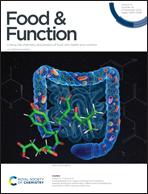Component analysis and anti-pulmonary fibrosis effects of Rosa sterilis juice†
Abstract
Rosa sterilis is a new variety of Rosa roxburghii Tratt, and is rich in bioactive substances, but its role in pulmonary fibrosis has not been elucidated. The purpose of this study was to investigate the potential components of Rosa sterili juice (RSJ) and its anti-pulmonary fibrosis effects. We employed HPLC–Q-Exactive Orbitrap–MS, HPLC, and ICP–MS to analyze the composition of RSJ, and carried out free radical scavenging assays to determine its antioxidant activity. Then, the anti-pulmonary fibrosis effect of RSJ was evaluated using the bleomycin-induced mice model and the TGF-β1-induced cell model. A total of 49 components were identified in RSJ, and the vitamin C content was 11.29 ± 0.05 mg mL−1. Catechin was the most abundant phenol, and potassium was the highest mineral element in RSJ. Attractively, we found that RSJ alleviated bleomycin-induced inflammation infiltration and tissue injury, and inhibited TGF-β1-induced epithelial–mesenchymal transition and fibroblast differentiation through the Smad2/3 signaling pathway. In conclusion, we discovered a new health-protective activity of Rosa sterilis, and the high levels of polyphenols, flavonoids, and vitamin C may be the basic anti-fibrosis substances.



 Please wait while we load your content...
Please wait while we load your content...